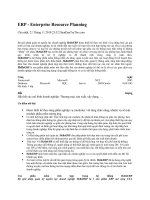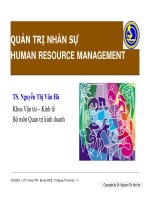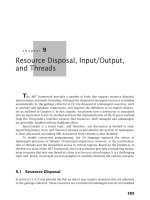lect11 chap21 resource
Bạn đang xem bản rút gọn của tài liệu. Xem và tải ngay bản đầy đủ của tài liệu tại đây (1.61 MB, 20 trang )
Geologic Resources
Chapter 21
Oil Field in Wyoming
Geologic Resources and Earth’s Systems
• Geologic resources - valuable materials of geologic
origin that can be extracted from the Earth
– Many geologic resources originate in the hydrosphere
• Petroleum and coal come from organisms that lived and died in water
• Halite (salt) and other evaporite minerals come from dry lake beds
– Weathering interactions between geosphere, atmosphere and
hydrosphere produce metal oxide ores
– Humans (biosphere) interact directly with the geosphere,
hydrosphere, and atmosphere when extracting and utilizing
geologic resources
– Groundwater (hydrosphere) is a renewable geologic resource
• If it can’t be grown, it must be mined
Types of Geologic Resources
• Geologic resources are grouped
into three major categories:
– Energy resources - petroleum
(oil and natural gas), coal, uranium,
geothermal resources
– Metals - iron, copper, aluminum,
lead, zinc, gold, silver, platinum
– Non-metallic resources - sand
and gravel, limestone, building
stone, salt, sulfur, gems, gypsum,
phosphates, groundwater, etc.
Resources and Reserves
• Resources - the total amount of
a valuable geologic material in
all deposits, discovered and
undiscovered
• Reserves - discovered deposits
of geologic resources that can
be extracted economically and
legally under present conditions
– The short-term supply of a
geologic materials
Energy Resources - Coal
• Fossil fuels (oil, natural gas,
and coal) account for nearly
90% of U.S. energy
• Coal is a sedimentary rock that
forms from the compaction of
plant material that has not
completely decayed
– Forms from shallow burial and
compaction of peat
Energy Resources - Coal
• Four varieties of coal
– Lignite (brown coal) is soft and crumbly
– Sub-bituminous and bituminous coal (soft coal)
• black and dusty
• burn with a smoky flame
• commonly strip-mined
– Anthracite (hard coal)
• shiny and dust-free
• burns with a smokeless flame
• low-level metamorphic rock
• Burning of high-sulfur coal can produce
acid rain; strip mines can scar landscape
• U.S. coal reserves could last for centuries
Energy Resources
-Petroleum
• Petroleum - oil and natural gas
- occurs in underground pools
• Occurrence of oil pools requires:
– A source rock (rich in organic matter)
– A reservoir rock in which it can be
stored and transmitted (e.g., sandstone)
– An oil trap (set of conditions holding
rock in reservoir rock and preventing
migration)
– Deep enough burial (and sufficient
time) to “cook” the oil and gas out of
the organic matter
Structural Traps
for Gas and Oil
2300 m – 4600 m = Oil formation
4600+ m
= Gas formation
Energy Resources - Petroleum
Eroded anticline forms trap in Landers oil field in Wyoming.
Other Oil Traps in Geological Structures
Petroleum Recovery
• Oil fields are regions underlain
by one or more oil pools
– Largest in U.S. are in Texas and Alaska
• Oil and natural gas are removed
through wells drilled down into an
trap within a reservoir rock
• Negative environmental effects
resulting from oil recovery and
transport include oil spills, brine
contamination of surface water,
and ground subsidence
oil
Oil Peak, Oil Panic ?
(Study by Amos Nur - Stanford)
U.S., Canada, Japan, Germany, France, Italy, UK, are the biggest
consumers of oil reserves worldwide.
Oil Peaks – 1960's
In the 1850's oil mainly used
for kerosene lamps – remaining
was burned or disgarded.
Current oil production rates peaked
in 1960's but U.S. consumption rates
increase dramatically above this.
Don't panic!
-Try to conserve energy
-Seek alternative energy sources
Petroleum Reserves
At current rate of use, worldwide oil reserves should last 30-40 years,
and natural gas reserves somewhat longer (estimates from USGS)
Petroleum Reserves
• As petroleum prices rise, alternate
petroleum sources, such as heavy
crude, oil shale and oil sand, will
be increasingly exploited
– Heavy crude is dense, viscous petroleum
– Oil shale is black or brown shale with high
solid organic matter content from which oil
can be extracted by distillation
– Oil sands (or tar sands) are asphalt-cemented
sand or sandstone deposits
Jobs and Salaries in Geology
Starting salaries for petroleum geologists with 0-2 yrs experience.
Mixture of B.S. and M.S. Degrees.
Jobs and Salaries in Geology
Geologists in Environmental (e.g. EPA, Geotechnical firms) and
Geologists in Government make $ 50 K – 75 K
Geology Ph.D. faculty starting salaries in 2007 ($70 K – 80 K)\
Metals and Ores
• Metal ores - naturally occurring
materials that can be profitably mined
• Whether or not a mineral deposit is an
ore depends on chemical composition,
the percent extractable metal, and
current market value of the metal
• Metallic ore deposits originate from
crystal settling in igneous intrusions,
hydrothermal fluids cooling in pores
and factures, chemical precipitation
in water, or sedimentation in
rivers (placers)
Mining and Metals
• Mining can be done at Earth’s surface
(strip mines, open-pit mines, and
placer mines) or underground
– Metals mined include iron, copper,
aluminum, lead, zinc, silver, gold and
many others
• With care, negative environmental
effects of mining, including unsightly
tailings piles, surface scars, land
subsidence, and acid mine drainage
can be minimized
Non-metallic Resources
• Non-metallic resources - not mined to
extract a metal or an energy source
– construction materials
• sand, gravel, limestone, and gypsum
– agriculture
• phosphate, nitrate and potassium compounds)
– industrial uses
• rock salt, sulfur, asbestos)
– gemstones
• diamonds, rubies, etc.
– household and business products
• glass sand, fluorite, diatomite, graphite)









